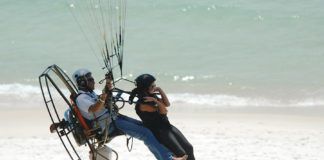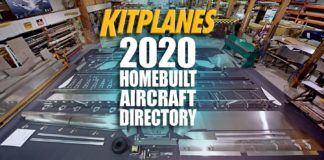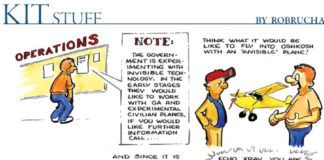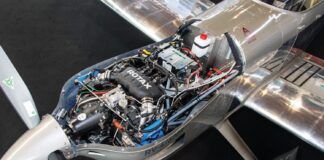Bill Mileskis Zenith CH 701 N701MW is a Zenith CH 701 from a year 2000 kit; it left the ground for a perfect first flight on May 5, 2006. I never imagined it could take so long to complete, but I suppose getting married, having a child, doing an addition to a house, moving and building a 2500-square-foot hangar were factors-in addition to the rest of normal life! Learning about all aircraft systems is great, but the exhilaration of fi rst flight (especially in a STOL) is hard to describe. Even harder to describe were the feelings during the few seconds before taking the active runway for the fi rst time, not knowing how it would work out but being totally committed to leaving the ground-a unique experience! It has a 912S engine, a BRS chute, and performance is better than expected. Paint is Imron, and vinyl graphics were conveniently designed, cut and installed at the hangar by a local mobile graphics fi rm. Support from my parents and wife, and especially my brother Paul and hangar partner Gary, were important in getting this project completed. The Zenith factory and Skyshop were very helpful, and the Zenith e-mail list is irreplaceable. LEDYARD, CONNECTICUT Ray Doerrs RV-10 On Friday May 26, 2006, N519RV took to the sky for the fi rst time with Joseph Shetterly (A10 pilot in the Air Force) at the controls. He said it GARDNER, KANSAS (K34) Bob Enniss RotorWay 162F My RotorWay Exec kit arrived as a series of crates in June 2003. Factory assistance was and continues to be exemplary, but slow progress because of a hectic work schedule coupled with my own inexperience made me soon realize that I needed help. I found that help in Homer Bell, the Human Quickbuild Program. With his guidance, we accomplished more in six days than I would have done on my own in years. Preliminary hover tests began in late May 2004, and by January 2005, 2756E was completed and signed off for formal flight testing. It has been flying wonderfully since then. Almost 600 hours went into construction. The paint scheme uses two colors of Chromillusion paint for the trim, so these colors change depending on your viewing angle. As a longtime reader of KITPLANES, I had often wondered why builders felt it necessary to give so many thanks to so many others upon the completion of their projects. As my RotorWay approaches the 40-hour mark, I now can understand their gratitude. I would not be flying my aircraft today without the help and support of Homer Bell, Rich Hodge, Jack Sturges, my wife, Alexandra, and my son Matthew-and most of all Tom and Mark at RotorWay factory support. Each one contributed time and talent to help me build an aircraft of which I am truly proud and which draws attention on every ramp. NEVADA CITY, CALIFORNIA Matt Hlavacs Breezy Breezy N5150 was completed over a four-year period with just north of 3000 hours of build time. The airframe is all 4130 chrome-moly steel, TIG welded, sandblasted and powdercoated. The powerplant is a Lycoming O-320 E20 rebuilt from a Cessna 172, swinging a Sensenich 74×48 prop. The wings are Wag-Aero, built up from its 2+2 aluminum spar and wingrib kit, and are covered in PolyFiber and painted with PolyTone. Th e wingstruts are modified Piper Super Cub. I departed from the plans, as I wanted dual sticks and dual rudder pedals. I also knew an electrical system was needed; it really helps to have a transponder and a solid radio (or two) in San Diego. A larger powerplant drives the electrical and helps carry my 200 pounds plus 36 gallons of fuel and a passenger. The landing gear and engine tower were also beefed up. I really enjoy fabricating, machining and welding, so building N5150 was a great pleasure. Sure beats reality TV, too. The N number honors all my fans who stopped by during the build and said, You must be nuts to spend that much time and effort on a plane with no fuselage that is going to fly so slow. 5150 is police code for mental case. Th e Breezy flies great. I put 52 hours on it between January and June 2006. I have given 22 rides in the last 12 hours and everyone has loved it-or so they said. Many thanks to my wife, Christina, daughter Bella and my constant hangar companions Chewy and Ripley, our four-legged kids. SAN DIEGO, CALIFORNIA
mailto:[email protected]
flew great and had amazing performance. It is powered by an IO-540-D4A5 (rebuilt by Americas Aircraft Engines) with a Hartzell blended airfoil prop. It is equipped with a full Garmin IFR stack and Dynon EFIS and engine monitor. Over the long weekend, Joe and his dad, Greg Shetterly (Boeing 757 pilot and ATP examiner), took turns at the controls and managed to fly off 17.5 hours while I was on the ground recording data and providing support and maintenance- and the credit card for the fuel. I would like to thank these two guys for offering to fly off the 25 hours. I would also like to thank my wife, Michele, for putting up with airplane parts all over the house for the year and 10 months while I was completing this slow-build project. Thanks also to my EAA Tech Counselor, Dale Rose, for all the support during the build process.
[email protected]
[email protected]
[email protected]













